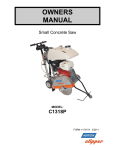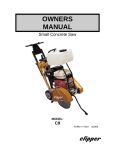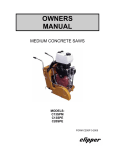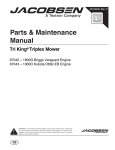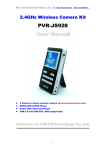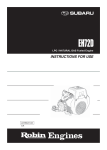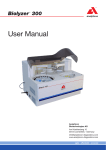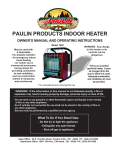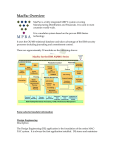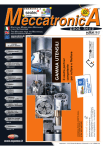Download Wahl C13 User's Manual
Transcript
OWNERS MANUAL Small Concrete Saw MODEL: C13 FORM <<7317 3/2005 WARRANTY Norton warrants all products manufactured by it against defects in workmanship or materials for a period of one (1) year from the date of shipment to the customer. The responsibility of Norton under this warranty is limited to replacement or repair of defective parts at Norton's Gainesville, Georgia factory, or at a point designated by it, of such part as shall appear to us upon inspection at such point, to have been defective in material or workmanship, with expense for transportation borne by the customer. In no event shall Norton be liable for consequential or incidental damages arising out of the failure of any product to operate properly. Integral units such as gasoline engines, electric motors, batteries, tires, transmissions, etc., are excluded from this warranty and are subject to the prime manufacturer's warranty. This warranty is in lieu of all other warranties, expressed or implied, and all such other warranties are hereby disclaimed. Important: Before placing equipment in operation, record the following information. MODEL:_________ SERIAL NO.___________ PURCHASE FROM: _____________________ ADDRESS: ____________________________ CITY_______ STATE ______ ZIP ________ TELEPHONE NO. ______________________ Before using this equipment, make sure that person using it read and understand the instructions in this owner’s manual. 2 Table Of Contents CONTENTS PAGE I. Preparation A. Safety Precautions B. Assembly C. C13 Series Concrete Saw Specifications D. Engine Specifications E. Pointer Alignment 4-6 7 8 9 9 II. Operation A. Blade Installation B. Starting The Engine C. Water Supply D. Operating The Saw E. Cutting Technique 9-10 10 10-11 11 12 III. Maintenance A. Engine B. Bearings C. V-Belts D. Depth Control 13-14 14-15 15-16 16 IV. Parts List Section A. Ordering Information B. Parts Drawing C. Service Parts List 17 18-19 20 Read Owners Manual Before Use Safety Alert Symbol: Information Following This Symbol Is Very Important. Use Only Clipper Diamond Blades 3 I. PREPARATION A. Safety Precautions Important! The following safety precautions must always be observed. Hazard Symbols Fuel (gasoline) is extremely flammable and its vapors can explode if ignited. Store gasoline only in approved containers, in wellventilated, unoccupied approved areas, and away from sparks or flames. Do not fill the fuel tank while the engine is hot or running. Do not start the engine near spilled fuel. Never use the fuel as a cleaning agent Engine components can get extremely hot from operation. To prevent burns, do not touch the engine or related parts while the engine is running or immediately after it is turned off. Never operate the engine with any heat shields or guards removed. Keep all guards in place when operating any piece of equipment Keep hands, feet, hair, and clothing away from all rotating parts Lethal Exhaust Gas use only in well ventilated areas. Engine exhaust gases contain poisonous carbon monoxide, which is orderless, colorless, and can cause death if inhaled. Avoid inhaling exhaust fumes, and never run the engine in a closed building or confined area Never tamper with the governor components of settings to increase the maximum speed. Severe personal injury and damage to the engine or equipment can result if operated at speed above maximum. Always obey the maximum speed rating of blade. DO NOT LIFT THE SAW BY THE HANDLE BARS 4 Dust and Silica Warning Grinding/cutting/drilling of masonry, concrete, metal and other materials can generate dust, mists and fumes containing chemicals known to cause serious or fatal injury or illness, such as respiratory disease, cancer, birth defects or other reproductive harm. If you are unfamiliar with the risks associated with the particular process and/or material being cut or the composition of the tool being used, review the material safety data sheet and/or consult your employer, the material manufacturer/supplier, governmental agencies such as OSHA and NIOSH and other sources on hazardous materials and make certain to comply with all product warnings and instructions for the safe and effective use of the material being cut. California and some other authorities, for instance, have published lists of substances known to cause cancer, reproductive toxicity, or other harmful effects. Control dust, mist and fumes at the source where possible. In this regard use good work practices and follow the recommendations of the manufacturer/supplier, OSHA/NIOSH, and occupational and trade associations. Water should be used for dust suppression when wet cutting is feasible. When the hazards from inhalation of dust, mists and fumes cannot be eliminated through engineering controls such as either vacuum and/or water mist, the operator and any bystanders should always wear a respirator approved by NIOSH/MSHA for the material being cut. Use Approved: Eye Protection Hearing Protection Respiratory Protection 5 Head Protection 1. Before mounting any blade on the saw, the blade should be inspected for any damage which might have occurred during shipment, handling or previous use. 2. The blade collars and arbors should be cleaned and examined for damage before mounting the blade. 3. The blade must be properly fitted over the arbor with the drive pin on the outside collar projecting through the drive pin hole on the blade and inside collar. 4. The blade shaft nut, which is a left-hand thread nut, must be tightened securely against the outside blade shaft collar. 5. The blade must be operated within the specified maximum operating speed listed on the blade. 6. Turn water control valve to full to provide adequate coolant (4 to 6 gallons per minute) for diamond blades and wet cutting abrasive blades. Insufficient coolant could result in severe blade breakage or diamond segment separation. 7. The blade guard must be in place with the nose guard down and locked when the saw is running. 8. The operator should wear safety glasses and any other appropriate safety equipment. 9. When starting the saw, the operator should stand away and to the side of the blade. 10. If for any reason the saw should stall in the cut, raise the blade out of the cut. Check the outside blade shaft collar and nut for tightness. Inspect the blade for damage before restarting the saw. Use caution when resuming a cut. Be certain that the blade is in alignment with the previous cut. 11. During cutting operations, do not exert excess side pressure on the handles as a method of steering. Do not force the blade into the cut by lowering the blade too fast or by pushing the saw too fast. You Are Responsible For Your Safety!!! 6 I. PREPARATION B. Assembly The compact concrete saws are shipped completely assembled and ready for use except for diamond blade, gasoline, oil, and handle bar. Inspect the saw for shipping damage. If any damage is found, contact the shipper immediately and file a freight claim. The Norton Company is not responsible for any freight-related damages. Remove the saw from the pallet. Reverse the position of the handlebars so that the handle bar sticks out towards the operator. Adjust the handlebars to the desired height. Attach the handlebars to the saw with the supplied hardware. Read and understand the remaining sections of this Owners Manual. NOTE: Do not install the blade until it is time to use the saw. ANSI regulations prohibit the transportation of any concrete saw with the blade installed. Part # 027021 028098 027006 Description Screw Din931 M10 x 25 Hex Head Cap Screw Din933 M10 x 65 Hex Head Cap Nut Din934 M10 HFX 7 QTY 1 1 2 C. C13 Series Concrete Saw Specifications Dimensions/Weight Length (Working) Length (Transport) Width Height Weight Engine Engine Mfg. Spec No. Engine Type Horse Power Max Torque Model Model Cooling System Oil Capacity Fuel Capacity Fuel Type Low Oil Sensor Air Filtration Characteristics Max Blade Depth of Cut 16” (406 mm) 14” (356 mm) 12” (305 mm) Arbor Bore Blade Shaft Locking Device Blade Shaft Speed Depth Control Depth Lock Depth Gauge Number Of V-Belts Blade Guard Type Right or Left Side Cutting Lifting Bale Handle Bars Water Tank Water Tank Capacity Water Hose Connector Recessed Rear Wheels Sound pressure1 Sound power1 45.66” (1160 mm) 33.50” (850 mm) 39.50” (1003 mm) 39” (990 mm) 220 lbs (100 kg) Honda GX390K1QXC9 Single Cylinder 4 Cycle 13 hp (9.5kW) @ 3,600 rpm 19.5 ft-lbs (26.5 Nm, 2.7 kg-m) @ 2,500 rpm GX390K1QXC9 GX390 Air 1.1 liter (1.16 US qt) 6.5 liter (1.79 US gal) Unleaded Gasoline (86 pump octane) Yes Four Stage Cyclone ∅16” (406 mm) 5.75” (146 mm) 4.75” (121 mm) 3.75” (95 mm) 1” (25.4 mm) Machined Into Flats Of Tight Collar 2850 rpm Hand Wheel With Screw Feed Standard Customer Installed Accessory 4 Hinged, All Steel Construction Yes Built In Adjustable, Stays Level At All Times Standard 5.28 US Gallons (20 liter) Standard Garden Hose With Flow Control Valve Standard 88 db(A) 105 db(A) 1) the sound measures have been made following pr EN 12638, Annex A; 8 2)“ Floor sawing, grooving and milling machines – Safety “ D. Engine Prior to attempting to operate the engine, read the information contained in the engine owner's manual. An engine owners manual is supplied with every gasoline powered concrete saw. 1. Check Oil: Add oil if low. Refer to the engine owner's manual for the recommended SAE viscosity grades. Capacity of oil is 1.1 liters (1.16 US qt) 2. Check Fuel: Fill if low. Use only unleaded gasoline with a pump sticker octane rating of 86 or higher is recommended. Never use an oil and gasoline mixture! 3. Air Cleaner: Never run the engine without the air cleaner! Rapid engine wear will result from contaminants being drawn through the carburetor and into the engine. 4. Engine Starting: Refer to the engine owner's manual for proper engine starting procedure. E. Pointer Alignment 1. Use a straight edge, and carefully mark a line 12 feet long on a smooth level surface. 2. Place the saw blade on the marked line, move the saw to the center of the marked line and then lower the blade until it is about 1/16” above the marked line 3. Measure from each end of the saw frame to insure that the frame is parallel to the marked line. Adjust the saw as needed. 4. With the blade centered on the marked line and the saw frame parallel to the marked line, lower the front pointer. 5. Adjust the pointer by bending it until is aligned with the marked line. II. OPERATION A. Installing the Blade 1. Disconnect the spark plug. 9 2. Remove the blade shaft nut, (Turn clockwise) , and remove the outside collar. 3. Clean off any foreign particles on the clamping surfaces of both collars and on the mounting surface of the blade. 4. Place the blade on the blade shaft, lining up the drive pin hole in the blade with the drive pinhole in the inside collar. Use only Clipper Diamond Blades. This machine was not designed for the use with abrasive blades. 5. Slide the outside blade shaft collar onto the blade shaft . The drive pin on the outside collar must project through the drive pin hole in the blade and into the inside collar. 6. Tighten the blade shaft nut (counter-clockwise) securely against the outside collar. 7. Reconnect the spark plug. Blades Use Only Clipper Diamond Blades B. Starting the Engine 1. Refer to the engine owner's manual for the proper starting procedures. 2. Always cut with engine rpm in the full throttle setting. C. Water Supply Pressurized source: Turn the water control to full "ON" when using wet cutting blades. The required flow rate is 4-6 gallons per minute. Water Tank on saw: This supply is designed for use with dry blades to keep the dust levels down. The tank will not supply the proper water flow rates when used with wet cut only blades. Do not drink the water from this tank. Fill the tank with water only. Close the water tank valve. Attach the saws water supply hose to the tank outlet. Fill the tank with water. The capacity of the tank is 5 US Gallons. When you are ready to cut, adjust the water supply rate until a fine mist or a slow trickle is made. The 10 use of water greatly decreases the amount of dust produced during the cutting process, aids in the cooling of the blade, and provides additional stability. • • Use Only Water In The Water Tank Do Not Drink From The Tank D. Operating the Saw 1. For blade installation instructions see section II. Operation sub heading A. Installing the Blade. For the engine starting instructions, see the Engine manual and follow the instructions located in section II. Operation sub heading B. Starting the Engine. 2. Check the Engine Oil level. 3. Raise the saw to the full upright position. Do not let the blade come in contact with the ground. 4. Maneuver the saw to the desired starting point. 5. If wet cutting, connect the water supply to the saw. 6. Follow the instructions for starting the engine found in the Engine manual. 7. If wet cutting, turn on the water supply at the source and then open the water valves on the saw. Make sure that there is a minimum of 4-6 gallons per minute of water flow!! 8. Be sure the engine is running at full throttle!!! 9. Slowly lower the blade by rotating the hand wheel clockwise until the desired depth of cut is reached. Use a reasonable rate of feed. Do not force the blade into the cut!! 10. When the end of the cut is reached, slowly raise the blade out of the cut by rotating the Hand Wheel counter-clockwise until the blade is at least one (1) inch above the ground. 11. Only move the saw in reverse with the blade in the raised position. 11 13. When moving the saw to a new location, be sure the blade is not touching the ground. Always pay close attention to where you are moving and where the blade is at all times. E. Cutting Technique Lower the blade into the concrete to the required depth by turning the hand wheel clockwise. Reduce the forward pressure if the saw begins to stall. Note: For deeper cuts (4 inches or more), several cuts should be made in incremental steps of 1-1/2 to 2 inches until the desired depth of cut is reached. Push the saw steadily forward using the front pointer as a guide. Exert enough forward pressure so that the engine begins to labor, but does not slow down. If the saw begins to stall, reduce the forward movement until full rpm is restored to the blade. If the saw stalls, raise the blade out of the cut before restarting. Avoid excessive side pressure or twisting of the blade in the cut. Additional Guide Lines For Sawing: • Understand and follow all of the instructions in this owner’s manual. • If wet cutting, turn on the water supply so that there is a minimum of 4-6 gallons per minute of water flow!! • In critically hard aggregate, more than a single pass may be needed to cut the desired depth. • If the saw stalls in the cut, immediately stop the forward speed and raise the blade out of the cut. If this is not done the belts can fail or the blade may be damaged. • Go slowly with a new blade until it opens up, that is, until the diamonds can be seen and felt. 12 III. MAINTENANCE A. Engine Follow the below schedule for engine maintenance. NOTE: Check the Honda Engine manual that came with the engine for any changes to the maintenance schedule. If the charts have any differences, follow the chart in the Honda Engine Manual. The Norton Company does not warranty the engine. If any warranty or service of the engine is required contact your nearest Honda service center, or from the Internet: http://www.hondaengines.com/home.htm Honda engine ( refer to owner's manual for complete maintenance.) Check the engine oil level before each use when the engine is cool and the engine is level. Add oil if the level is low. The oil level should be within the operating range (see the eninge owner’s manual for details). Only use a high-detergent, premium quality motor oil certified to meet or exceed U.S. automobile manufacturer’s requirements for Service Classification SG, SF/CC, CD. Motor oils will show the classification on the container. A SAE viscosity of 10W-30 is recommend by Honda for general, all temperature use. Please consult the below chart or contact your local Honda service center for the proper viscosity for your temperature range. 13 Always refer to the engine manual for more detailed information on checking the oil, changing oil, and oil capacity, air filter changes, and fuel type to use. Use only Honda air filters. Do not clean the air filter with gasoline or other flammable solvents. A fire or explosion could result. To clean, follow the instructions found in the Honda engine manual. Dry Cutting Engine Maintenance 9 When operating the engine in dry cutting or dusty environments the following is required: 9 Engine oil changed more often. 9 Every 50 hours (or more often if conditions require) clean all of the engine cooling fins. 9 Every 25 hours (or more often if conditions require) clean the engine precleaner. 9 Every 100 hours (or more often if conditions require) replace the air filter. If the engine is equipped with a reusable air cleaner, clean and re-oil it. 9 Check and clean the air filter after each use. Replace as needed. B. Bearings Re lubrication type bearings must be relubricated daily to assure long life. The grease used should conform to the NLGI grade two and be free of any chemical impurities such as free acid or free alkali, dust, rust, metal particles or abrasives. 14 For best results, bearings should be relubricated while in operation. Note: Due caution for personal safety must be observed when servicing rotating equipment. The grease should be pumped in slowly until a slight bead forms around the seals. This bead, in addition to acting as an indicator of adequate relubrication, provides additional protection against the entry of foreign matter. If necessary to relubricate while the bearing is idle refer to relubrication table for maximum grease capacity for the various size bearings. Shaft Size Maximum Grease Capacity of Bearing Chamber in Ounces 1/8 3/8 5/8 1/2"' to 3/4" 7/8" to 1-3/16" 1-1/4" to 1-1/2" C. V-Belts Warning: Never make adjustments to belts or pulleys while engine is running! 1. The best tension for a belt drive is the lowest tension at which the belts will not slip under full load. 2. Simply take up the drive until the belts are snug in the grooves. Run the drive for about 15 minutes to "seat" the belts. Then impose the peak load. If the belts slip, tighten them until they no longer slip at peak load. 3. Remember, too much tension shortens belt and bearing life! FIGURE 1 4. Check the belt tension frequently during the first day of operation. Check the belt tension periodically thereafter and make any necessary adjustments. 5. The two most common causes of misalignment are shown in the drawing. a). The engine drive shaft and the blade shaft are not parallel. b). The pulleys are not located properly on the shafts. 6. To check alignment, all you need is a steel straight edge. 15 FIGURE 2 7. Line up the straight edge along the outside face of both pulleys as shown in the drawing. 8. Misalignment will show up as a gap between the pulley face and the straight edge. 9. Make sure that the width of the outside land (area between the belt and the edge of the pulley) is equal on both pulleys. D. Depth Control The depth control (raising screw) consists of a threaded rod, which feeds into a brass nut. In order to keep the two parts working smoothly it is necessary to keep the rod free from dirt and sludge as much as possible. Cleaning the threaded rod with a rag after each use will prevent sludge from collecting in the tube assembly and protect the threads. It is a good practice to keep the raising screw threads lubricated, as the slurry generated during cutting will cause premature thread wear. The bearing used to support the raising screw should be checked after each use to make sure it is turning freely and lubricated. If the bearing requires re lubrication lithium base grease is recommended. 16 IV. PARTS LIST SECTION A. Ordering Information 1. List model number and serial number of machine. 2. List part number and serial number of part not the item number. 3. Wherever alternate parts are shown due to product improvement, inspect the part you have and provide additional description as necessary. 4. Specify mode of shipping desired, such as, parcel post, truck, U.P.S., best way, etc. For the nearest Clipper distributor call 1-800-554-8003 Common Replacement Parts Description Belts V-belts XPZ 780 LW (set of 4) Blade Shaft Nut ¾-16 Left Hand Thread (Operators Right Side Of Saw) Blade Shaft Nut ¾-16 Right Hand Thread (Operators Left Side Of Saw) Collar Tight (Operators Right Side) Collar Tight (Operators Left Side) Collar Loose Assembly (With Pin) Drive Pin ∅3/8 x 1 Bearing Blade Shaft (1) Front Wheel Complete (1) Rear Wheel (1) Wrench 1-1/2” Wrench 32mm Wrench 17mm Part Number 80519 227156 227191 227159 227190 227247 227154 72474 82786 80991 105377 82910 72279 NOTE: All Parts Are Sold As Individual (each) Unless Noted Otherwise Blades Use Only Clipper Diamond Blades. Contact your local Clipper Distributor or Clipper at 1-800-554-8003 for the best blade for the application. 17 18 19 Item 1 2 3 4 5 6 7 8 9 10 11 12 13 14 15 16 17 18 19 20 21 22 23 24 25 26 27 28 29 30 31 32 33 34 35 36 37 38 39 40 DESCRIPTION Qty Part No Basic Frame 1 83352 Rear axle assy. 1 82784 Rear Wheel 2 80991 Rear axle 1 82785 Front wheel complete 2 82786 Bushing Iglidur 20/23/11 4 80999 Bushing Iglidur (set of 2) 2 80297 Screw Feed.Spindle 1 82787 Raise-lower screw + key 1 83353 Bearing + Screw 1 76670 Stop ring A20 1 82789 Depth screw locking 1 83354 Handwheel + nut 1 76357 Handle 1 73428 Handwheel + Handle 1 76465 Handle Grip 1/2" 2 213633 Maneuvering bar cpl. 1 83355 Wrench 1"1/2 1 105377 Wrench 32mm 1 82910 Wrench 17mm 1 72279 Water Tank support 1 82792 Connector for Hose 1 9600017 Water cock 1 72357 Water tank complete 1 83357 Stopper for Water tank 1 82794 Blade shaft assy. 1 83358 Nut blade shaft right side 1 227156 (left threaded) Loose collar 2 227247 Nut blade shaft left side 1 227191 (right threaded) Inside collar right side 1 227159 (left threaded) Bearing for blade shaft 2 72474 Inside collar left side 1 227190 (right threaded) Blade shaft 1 83421 Blade shaft pulley 1 76347 Pointer Complete 1 80448 Blade guard assy 1 83365 Blade guard nut 1 83366 Blade guard axle 1 83367 Waterdistributor-Y 1 72286 Water supply tape 1/2" 1 107859 20 Item 41 42 43 44 45 46 47 48 49 50 51 58 59 60 61 DESCRIPTION Hose coupling Blade splash guard Motor frame Axle motor frame cpl Axle motor frame Brake complete Motor Honda Motor pulley compl. V-belts XPZ 780 LW (set of 4) Belt guard compl. Screws for motor (Set complete) Motor stop switch Water hose (set of 2) Reduction Blade shaft guard -NA- Pointer Bracket Qty 1 1 1 1 1 1 1 1 1 Part No 227116 82800 83369 82802 82803 82804 123327 81012 80519 1 1 83371 82814 1 1 1 1 227115 82998 83218 83363 1 99612-2 NOTES Norton Construction Products PO Box 2898 Gainesville, GA 30503 Phone: 800-554-8003 or 770-967-3954 (8:00 A.M. to 7:00 P.M. Eastern Time) Fax: 800-443-1092 or 770-967-7287






















